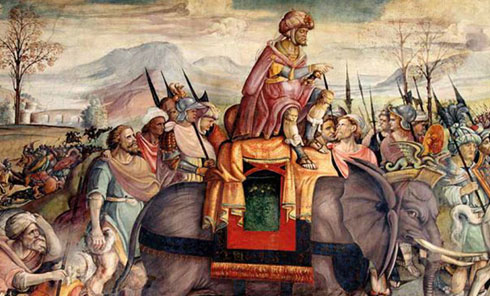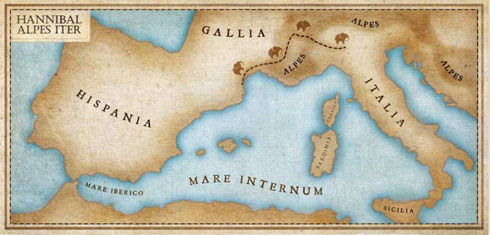How did Hannibal cross the alps?

Could ancient DNA and modern microbiology help answer a question that has puzzled historians and archaeologists for 2,000 years? Chris Allen explains
The Biologist 65(5) p16-19
A much-encouraged trend in scientific research has been the emphasis of ‘interdisciplinary’ research. The idea here is that if a biologist decides to start a research project with, say, a geologist or an organic chemist, then the result of such endeavour has the potential to answer bigger questions. Some of us not only endorse interdisciplinary research, but enjoy taking things a step further to progress to full-on ‘cross-disciplinary’ research. Such an undertaking invokes a need to not only work at the interface with other disciplines, but to jump fully into the deep end of another scientific field. Remember, the structure of DNA, that bastion of molecular biology, was elucidated by chemists and physicists. The scientific rewards can be great.
So it was that as a molecular microbiologist with an interest in cross-disciplinary research, I was invited to work with a team of geomorphologists and ancient historians investigating a very old and very unanswered problem: how did Hannibal cross the Alps?
This is no ordinary question. It has been around, with no obvious answer, for the last 2,000 years. Hannibal was a Carthaginian general who decided to invade the Roman republic in 218 BC. But he clearly wasn’t someone who liked to take the easy option. He decided to take his invading army not around but over the Alps, across into Italy from France, having started his epic trek at Cartagena in modern Spain. Yet no one documented fully or exactly where he crossed the Alps. The best we have is the report of the Greek Roman historian Polybius, who a few years later wrote a detailed account of the crossing. Polybius gave some tantalising clues, but little direct evidence of the route the famous general took.
There are also the writings of another famous Roman historian called Livy, but taken together they are full of inconsistencies. Neither author is able to clearly point out the route Hannibal took – with perhaps four or five most likely Alpine passes being possible from whichever angle the reader chooses to interpret the ancient writings. Polybius at least lived during Hannibal’s lifetime, so was able to interview eye witnesses.
What followed was almost 2,000 years of argument and debate among historians, linguists, archaeologists and politicians (even Napoleon got involved). One well-known British biologist and polymath, Sir Gavin de Beer, was a key modern-day exponent of probably the least popular of the well- known theoretical routes – across a pass called the Col de Traversette, which sits just under 3,000 metres above sea level near Mont Viso, between the Upper Guil Valley in France and the source of the River Po in Italy.
Polybius famously tells us that Hannibal included a contingent of 37 elephants in his army. However, more significantly, he also brought with him some 15,000–20,000 horses and other equines, and perhaps 50,000-plus men. The horses, especially, are key to the biological dimension of this story.
Professor Bill Mahaney, of York University in Canada, has been using geological methods to try to solve the famous riddle. I entered the story shortly after he found what he believed to be compelling evidence of the ‘rockfall’ mentioned in some translations of Polybius. So could we find scientific or even biological evidence that the Hannibal troupe passed through this route?
 Was this the route Hannibal took? Analysis of ancient DNA may help answer the age-old question
Was this the route Hannibal took? Analysis of ancient DNA may help answer the age-old questionMolecular markings
A field of molecular biology research that has generated much recent interest is the study of ancient DNA (aDNA for short). Perhaps surprisingly, DNA molecules can exist for hundreds or even thousands of years in specific environments. From ancient Egyptian tombs to Neolithic mounds, aDNA has allowed biologists to reveal new insights into the ancient past. This led us to ask whether Hannibal’s route across the Alps could be uncovered using this same approach.
Taking the lead from Polybius, we decided to look at the living things that followed the general at that time: not just the people, horses and elephants, but actually the bacteria that they carried. For example, the equine gut is a unique environment that contains many bacteria that have evolved specifically to survive in this habitat. Could the DNA of gut bacteria in Hannibal’s army have remained through the millennia?
Bacterial DNA is easily distinguished from DNA of other organisms and we know a lot about the type of bacteria found in the gut – we are able to tell the difference between DNA from bacteria in the gut and bacteria found elsewhere in some cases. In the horse’s large intestine and faecal matter, more than 70% of the bacteria present are Firmicutes from the class Clostridia. These bacteria are found in soil as well, but usually in much lower relative quantities (for example, less than 1–2% of bacteria in most soils are Clostridia).
Furthermore, Clostridia often produce vegetative structures called endospores, which are remarkably stable in soil and other environments. Some researchers have proposed that endospore DNA is therefore stable in soil for thousands of years. We realised that if Hannibal’s animals had left faecal Clostridia in the environment 2,000 years ago, DNA could still be there. These endospores would be like genetic time capsules waiting to be discovered.
Thanks to the revolution in molecular biology, we can now rapidly isolate and sequence environmental aDNA at low cost. Any experiment to test the hypothesis that Clostridia were left by Hannibal’s army would need to be carefully performed to assess a whole area, not just a few samples. Until recently, the costs for this would have been prohibitive. However, today we can analyse several billion DNA fragments in a single soil sample. This depth of analysis means that nearly whole genomes of bacteria can be assembled and analysed using high- performance computing.
Location, location, location
But where to sample? Large numbers of animals would need significant supplies of food and water if they were to survive in a high alpine meadow. Forage certainly would need to be carried with the army, due to limited grazing sites, but drinking water for animals would be at a premium.
Our team visited the Col de Traversette area in 2011 and found a small, boggy area with ponds of water that was just a 20-minute climb from the Traversette pass. Certainly within a few hours’ climb for a Carthaginian army. We decided to look for the aDNA we sought here.
First, we had to determine if the old bog was actually old enough. To do this, a core was taken through the mire and peat-like materials were carefully carbon dated back at Queen’s University Belfast. We found that the bog would indeed have been there during Hannibal’s time – it was almost 4,000 years old.
Next (two years later), we returned and dug another section: this time to look for ancient Clostridial DNA. If we were right with our hypothesis, endospore ‘time capsules’ should still be present in the highly anaerobic bog from Hannibal’s era. At the time, the place would have looked like a farmyard; 20,000 animals potentially grazing here would leave a lot of faeces over a very short period.
Again, we carefully recovered samples for carbon date analysis, but this time we also analysed same samples for phylogenetic markers for Clostridia. What we found was a direct correlation between the relative abundance of the phylogenetic marker 16S rRNA gene from Clostridia and soil samples with a carbon date analogous to 218 BC. We hadn’t disproved our hypothesis.
Media storm
The findings were exciting, but also preliminary. Nevertheless, the results were written up and published in the journal Archaeometry in 2016 (it took PhD student Dr Prasanna Pentlavalli three years to carefully analyse the DNA present using two independent approaches).
What wasn’t expected was the media interest this would generate. This was initiated through an article written for The Observer, whose science editor Philip Ball had recognised the significance of the Archaeometry articles immediately. Two years later, the story has led to two television programmes, more than 5 million TV viewers, and articles in The Smithsonian and The New Yorker.
Science is not about proof, it is about evidence. The work published to date gives a tantalising glimpse of what might be possible. There clearly is the potential to use microbiology to provide the most compelling evidence to date regarding this famous enigma. So what is next?
The first thing to point out is that the 16S rRNA gene is just one gene among many in the Clostridia genome. Presently, environmental microbiologists using metagenomics for analysis are moving away from sole use of the 16S gene as a diagnostic tool. The future is in whole genome analysis.
If there are 16S rRNA genes for Clostridia in the mire, and if the ‘time capsule’ idea is correct, there will also be a complete genome. Certainly, we would expect the genome of a gut Clostridium to harbour functional genes – for example, used for catabolism of commonly found intestinal fats – that are absent in soil Clostridia. Further, there may even be the potential to say from such whole genome analysis what type of gut – equine, for example – these bacteria came from.
One thing is certain: answers will be forthcoming. We have assembled genomes that are being painstakingly analysed for these functional genes. If they are there, we will know a lot more about how this incredible event may have happened all those years ago.
Professor Chris CR Allen FRSB is a cross-disciplinary microbiologist at the Institute for Global Food Security and School of Biological Sciences, Queen’s University Belfast.
1) Mahaney, W. C. et al. Biostratigraphic evidence relating to the age-old question of Hannibal’s invasion of Italy, I: History and geological reconstruction. Archaeometry 59(1), 164–178 (2017).
2) Mahaney, W. C. et al. Biostratigraphic evidence relating to the age-old question of Hannibal’s invasion of Italy, II: Chemical biomarkers and microbial signatures. Archaeometry 59(1), 179–190 (2017).


